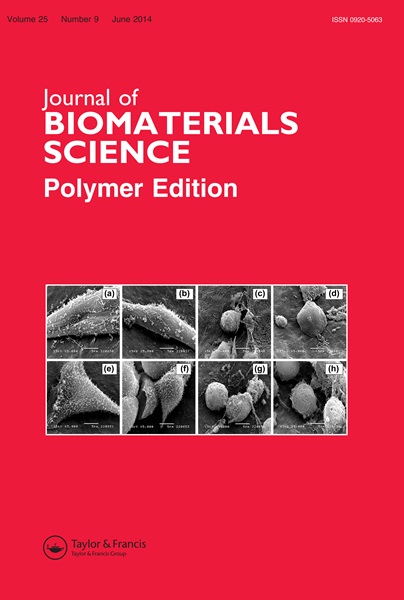生物医学应用中稳健的组织粘附性:增强可注射蛋白质水凝胶中聚合物的稳定性。
IF 3.6
4区 医学
Q2 ENGINEERING, BIOMEDICAL
Journal of Biomaterials Science, Polymer Edition
Pub Date : 2024-09-11
DOI:10.1080/09205063.2024.2398888
引用次数: 0
摘要
基于蛋白质的水凝胶具有兼容性、生物可降解性以及对生物和化学变化的适应性,因此是具有多种治疗用途的理想材料。因此,人们对粘附型水凝胶进行了大量研究;然而,大多数粘附型水凝胶的机械特性较弱、粘附性短暂、生物相容性差且拉伸强度低。我们在此报告的是一种双组分(BSA-明胶)蛋白质溶液与四(羟甲基)氯化磷(THPC)交联形成的新型水凝胶。与传统的粘合性水凝胶相比,这种水凝胶显示出更强的机械性能,与 L929 细胞具有生物相容性,并且具有最小的侵入性注射性。这种粘合水凝胶具有相当高的拉伸强度(73.33 ± 11.54 KPa)和无故障压缩机械性能(75% 应变时为 173 KPa)。此外,这种水凝胶的最大组织粘附强度可达 18.29 ± 2.22 千帕,明显高于纤维蛋白胶。细胞存活率为 97.09 ± 6.07%,表明这些水凝胶对 L929 无毒。在生理 pH 和 37 °C 条件下,BSA-明胶水凝胶的最快凝胶时间为 1.25 ± 0.17 分钟。因此,这项新研究成果可作为一种组织粘合水凝胶应用于生物医学领域。本文章由计算机程序翻译,如有差异,请以英文原文为准。
Robust tissue adhesion in biomedical applications: enhancing polymer stability in an injectable protein-based hydrogel.
Protein-based hydrogels are appealing materials for a variety of therapeutic uses because they are compatible, biodegradable, and adaptable to biological and chemical changes. Therefore, adherent varieties of hydrogels have received significant study; nevertheless, the majority of them show weak mechanical characteristics, transient adherence, poor biocompatibility activity, and low tensile strength. Here we are reporting, a two-component (BSA-gelatin) protein solution crosslinked with Tetrakis (hydroxymethyl) phosphonium chloride (THPC) to form a novel hydrogel. Compared with classical adhesive hydrogels, this hydrogel showed enhanced mechanical properties, was biocompatible with L929 cells, and had minimal invasive injectability. A considerable, high tensile strength of 73.33 ± 11.54 KPa and faultless compressive mechanical properties of 173 KPa at 75% strain were both demonstrated by this adhesive hydrogel. Moreover, this maximum tissue adhesion strength could reach 18.29 ± 2.22 kPa, significantly higher than fibrin glue. Cell viability was 97.09 ± 6.07%, which indicated that these hydrogels were non-toxic to L929. The fastest gelation time of the BSA-gelatin hydrogel was 1.25 ± 0.17 min at physiological pH and 37 °C. Therefore, the obtained novel work can potentially serve as a tissue adhesive hydrogel in the field of biomedical industries.
求助全文
通过发布文献求助,成功后即可免费获取论文全文。
去求助
来源期刊

Journal of Biomaterials Science, Polymer Edition
工程技术-材料科学:生物材料
CiteScore
7.10
自引率
5.60%
发文量
117
审稿时长
1.5 months
期刊介绍:
The Journal of Biomaterials Science, Polymer Edition publishes fundamental research on the properties of polymeric biomaterials and the mechanisms of interaction between such biomaterials and living organisms, with special emphasis on the molecular and cellular levels.
The scope of the journal includes polymers for drug delivery, tissue engineering, large molecules in living organisms like DNA, proteins and more. As such, the Journal of Biomaterials Science, Polymer Edition combines biomaterials applications in biomedical, pharmaceutical and biological fields.
 求助内容:
求助内容: 应助结果提醒方式:
应助结果提醒方式:


